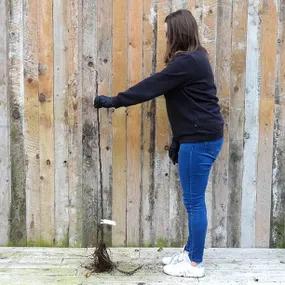Pitmaston Pineapple Apple Trees

The details
- Eating: Hint of pineapple flavour
- AKA Radcliffes NonPareil
- Spur bearer
- Self sterile .
- Pollinator
- Pollination Group D.
- Harvesting: October
- Stores 1 - 2 months.
Recommended extras
Description
Pitmaston Pineapple Apple Trees: Eating
The Pitmaston Pineapple - sometimes called Radcliffes NonPareil - is an exceptional apple with a powerful nutty flavour, honey sweet yet also sharp.
The name really refers to its warm yellow-russet colour and shape more than the flavour, which has at best a mild hint and aroma of pineapple - reminiscent, let's say.
Pitmaston Pineapples are very small, about 5cm across, and the trees tend to crop biennially, laden with fruit in alternate years, so they are rarely grown commercially, but make an outstanding addition to an orchard with children around, and anyway your neighbours won't be able to get their hands on them anywhere else!
Whilst not really a cooking apple, their flavour special enough that you should experiment with them in pies and other desserts.
The trees have an upright habit and are fairly vigorous, their flowers are also large and well structured.
The fruit are ready to eat in mid-October
Browse our range of apple trees, or all our fruit trees.
Read our guide to buying apples.
Delivery season: Bareroot plants are delivered in late Autumn to Spring, about November-March inclusive. Pot grown plants, year round.
Features:
- Eating: Hint of pineapple flavour
- AKA Radcliffes NonPareil
- Spur bearer (good for cordons & espaliers)
- Self sterile.
- Pollinator
- Pollination Group D.
- Harvesting: October
- Scab resistant
- Stores 1 - 2 months.
Growing Pitmaston Pineapples
Apples like rich, well drained soil, and will thrive on clay in locations that do not get waterlogged in winter.
A full day of sun and shelter from the wind is ideal.
The fruit need regular thinning.
Disease Notes:
Scab resistant.
Rootstocks:
We use MM106 for Pitmaston Pineapple, the UK standard for medium-sized trees, ideal for gardeners. It gives a half-standard about 4m tall, and a bush about 3m.
MM106 maidens are suitable for cordons and espaliers.
Pollination Partners
Your trees are self sterile and their flowers must be pollinated to make fruit.
Pitmaston Pineapple is in Pollination Group D, which cross-pollinates with other apple trees in Groups C, D and E.
Use our Fruit Pollination Checker to quickly find pollination partners, or Apple Tree Pollination Guide to learn more.
Planting Instructions
Did You Know?
An old West Midlands russet, recorded as a seedling of Golden Pippin in 1785 by a Mr White, an employee of Lord Foley of Witley.
It was presented to the London Horticultural Society in 1845 by Williams of Pitmaston nursery.
Apple Tree Delivery Shapes:
Most of our fruit trees are delivered in up to 3 shapes (maiden, bush, and half standard), and you can buy selected varieties as ready-made cordons and/or potted mini patio trees: scroll up to see what's in stock.
Maiden: Unbranched tree, the most basic starting size, which you can train into the other forms (apart from mini patio trees).
Bush: Freestanding tree with a short trunk about 60cm tall. It will grow to about 3m. Ideal for small gardens.
Half-Standard: A freestanding form with a trunk about 120cm tall. It will grow into a full sized, "normal" apple tree, about 4m. Ideal for orchards, easy to mow underneath.
Cordon: Pitmaston Pineapple is a spur-bearer, suitable for cordons and espaliers.
Mini Patio Tree: Only sold pot-grown, these use a dwarfing rootstock to drastically reduce the tree's vigour and restrict the mature size. They are suitable for large patio containers, and for small gardens where a normal-sized bush or half-standard form won't fit.
Guide to Fruit Tree Sizing.

 1.webp)
 1.webp)
 2.webp)
